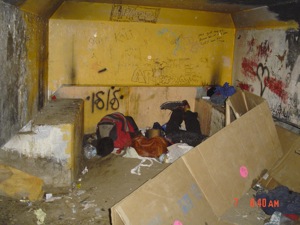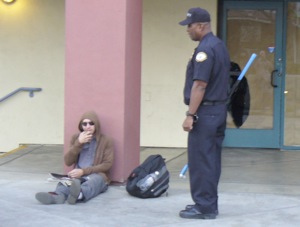-
- Joint Chiefs chair says he should not have voiced view that homosexuality is immoral
- McGreevey seeks custody of daughter, child support
- Baptist leader sparks furor with ‘Is Your Baby Gay?’ article
- Some gay rights advocates switching strategies on marriage debate
- Mothers send breast milk overseas to help keep babies HIV-free
- National News Briefs
- World News Briefs
san diego
Hillcrest tackles transients
Law enforcement, residents focus on homelessness
Published Thursday, 22-Mar-2007 in issue 1004
Jeremy, 29, slumps in a corner of the Uptown District Shopping Center, a hoodie covering his short blond hair, as he takes an afternoon nap. He wakes, startled, after a security guard pokes him in the calf with a long pole.
“Move along,” the guard says.
Jeremy unfolds his long legs and lopes into the Ralphs grocery store.
To many in Hillcrest, Jeremy is a symbol of what the Hillcrest Town Council (HTC), a newly formed neighborhood association, calls “the homeless problem.” To others, Jeremy is just another part of the community.
There are nearly 400 homeless citizens in District 3, according to a count taken in April 2006 by the San Diego Regional Task Force on the Homeless. Next to downtown, Hillcrest has the highest rate of transients in the city, which, overall, has approximately 1,200 people without a place to call home.
Hillcrest is attractive because it’s the easiest place to panhandle, says San Diego Police Department officer John Ampol, whom the SDPD has assigned to focus on the problem.
“[Transients] say they get the most handouts up here – people don’t ignore them. I think the other thing is that they can be aggressive, and some even say the fact that they are intimidating helps them to get money,” Ampol says.
The officer explains that all too often homeless people feel that people in Hillcrest are easy targets. A resident of the area himself, he cites a personal incident that occurred while off duty.
A female transient, who Ampol notes is one of the most polite people he comes in contact with when on duty, approached his personal vehicle and demanded a dollar. “I kind of laughed because I thought she’d recognized me and knew who I was. Instead, she got angry and began to curse at me and spit all over my car,” he says.
Stories like Ampol’s are not uncommon in Hillcrest. Residents are accustomed to being asked for spare change, but they’re concerned about more than panhandling. Grievances include shopping cart violations, graffiti, litter, crime, refuse removal, unauthorized collection of recyclables, littering, illegal lodging and sleeping on private property. “All of which are actually a violation of the municipal code,” says Ampol, who was on hand at a recent HTC meeting.
“Being homeless isn’t a crime, but there are certain violations that are committed by many of these individuals that are criminal,” he told the group.
There are several problems related to transients, Ampol explains.
There are nearly 400 homeless citizens in District 3, according to a count taken in April 2006 by the San Diego Regional Task Force on the Homeless. Next to downtown, Hillcrest has the highest rate of transients in the city. “The transients know where the goldmines are and where they can get the most amounts of recyclables and garbage worth something to them.”
There are also constant complaints of defecation and urination in the alleys, as well as illegal lodging in garages and complaints of abandoned shopping carts, he says.
“The problem isn’t only that it’s a nuisance to many of the residents,” explains Anne Garwood, a member of the HTC, “but it’s also the trash and litter the homeless leave behind when they take their shopping cart or pick up their belongings and move on. It degrades the area, and we’re left to clean it up.”
Ampol has gone to almost every shopping center in North Park, Hillcrest and University Heights to discuss shopping cart theft.
“[The carts] are not only an eyesore to the neighborhood, but it’s also expensive because the carts cost more than $200 each, and the collection companies charge the store $16 just to bring the cart back,” he says, adding that CVS bought 110 carts and only has three left.
Ampol has been working closely with the city’s neighborhood nuisance attorney to safely address such problems and says many people are on board for citing such crimes.
“The fine associated with such violations isn’t much but still it is a deterrent, especially for those on probation and chronic violators who are barred from the area.”
He suggests that business owners and residents fill out a letter of authorization, allowing police to go on to private property and enforce violations, such as trespassing, panhandling and illegal lodging on private property.
“Otherwise, without a complaint, officers do not have the right to enforce these laws. The letter gives a blanket approval from owners and basically states the police can take care of such violations when they see them out on patrol,” he says.
Ampol has collected more than 70 letters, mostly from businesses, whose owners, he says, are tired of the nuisance.
He also suggests that business owners and residents lock their recycling bins as a temporary measure until the matter of “dumpster diving” can be addressed.
But not all residents agree that the homeless are a problem in Hillcrest. Some believe that transients should be able to sleep where they want as long as it’s on public property, and they feel they are doing a good deed by giving handouts.
“They are people who have hit hard times and need help. If I have it to give to them at the moment, I will. After all, there are plenty of us who are just one paycheck away from where they are,” says Tania Blansit, a resident who gave Jeremy money for “food.”
Leo Wilson, an HTC meeting facilitator, doesn’t condone such actions. “The more they continue to enable the homeless people in the community, the more they are allowing them to get away with, and the less they are really helping them,” Wilson says. “Homeless advocates have a blind eye and don’t realize that these people are addicts and much of the underlying cause is mental illness. If we’re going to help them we need to get them to treatment centers. The more they continue to enable the homeless people in the community, the more they are allowing them to get away with and the less they are really helping them.”
“We try to offer services to the people we come in contact with through the Homeless Outreach Team (HOT),” Ampol explains. HOT is a program that offers essential services to transients. “It’s very successful for those who want assistance to get back on their feet,” Ampol says. However, he notes that the majority of the people he comes in contact with don’t want to conform to the rules of shelters and turn it down because they have to be sober.
As for Jeremy, thanks to Blansit’s generosity, he’s gathered enough change to buy a pack of smokes at Ralphs. On his way out, he stops to chat. “Hillcrest is my home,” he says. “I was in Hillcrest before living on the streets. This is the place I know the best and my friends are here.”
|
|
Copyright © 2003-2025 Uptown Publications



